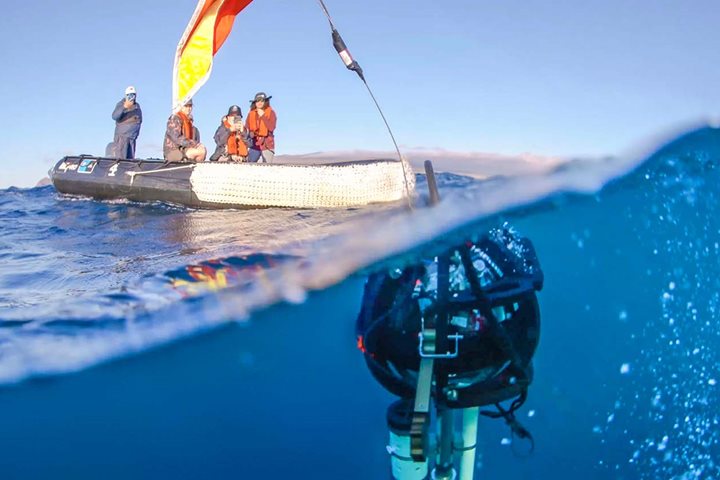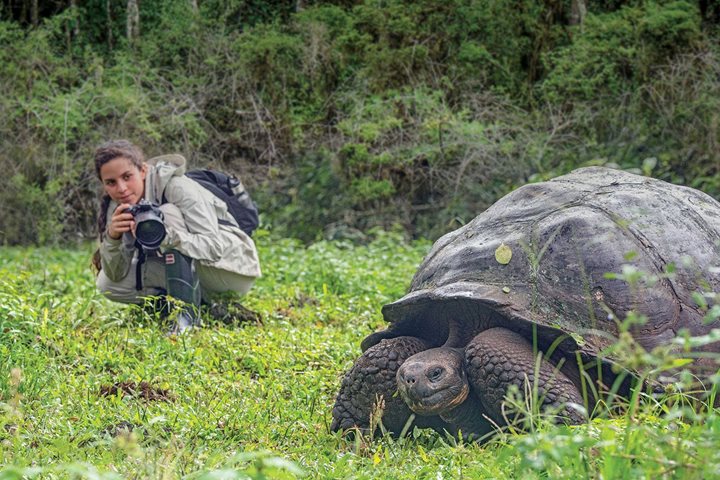Call +1300.361.012(AU) | 0800.444.462(NZ)
There is nowhere else on Earth like the Galápagos Islands. The wildlife is legendary for its lack of fear. You can stand mere feet from all kinds of interesting creatures—including some endemic ones found only on these islands—and carefully contemplate their fascinating daily behaviors. “It’s like going to a zoo but with one exception—you are inside the enclosure and a part of the story,” says Walter Perez, a Lindblad naturalist and author of Galápagos: Life in Motion, a book on the archipelago's wildlife. Take a look at some of our favorite animals in action.
Bluest Feet Wins the Prize
The blue-footed booby is famous for its highly ritualized courtship dance. Both males and females sport those eponymous eye-catching, teal-blue feet. But the color is especially important for the males—the bluer their feet, the better their chances of impressing a potential mate. So, their comical and endearing courtship centers around showing off those blues. Males slowly lift up each foot offering it to the female for inspection. Foot tone is a signifier of health and hardiness—so she can decide if he’ll make a worthy partner.
Read more
Sign up to receive thrilling stories from the Galápagos and travel inspiration from the most amazing places on the planet.
SubscribeFlirtation in Flight
The islands are home to two species of frigatebirds—magnificent and great—and both have a very unusual way of attracting the ladies. Males inflate a thin red pouch (or gular sac) on their throat to create a large balloon-like bulge. Thanks to the size of the pouch and the vibrant contrast of bright red against dark feathers, it’s easy to spot even from a distance. To add to their ostentatious display in the hopes of attracting a mate, males clatter their bills, wave their heads back and forth, and call at females flying overhead.
Read more
Salt-Sneezing, Sun-Basking Swimming Lizards
One of the archipelago’s most unusual creatures, marine iguanas often live in large colonies, where it’s common to see them piled on top of one another—a smart trick for conserving heat. After foraging for algae in the chilly ocean, these iguanas can lose up to 50°F of body heat. Gathering en masse and basking for hours in the sun helps them warm up before their next dive. Back on land they also have to rid their bodies of all the saltwater they ingest—look out for these frequent and funny “sneezes” as they expel the excess salt.
Read more
No Flight, No Problem
While cormorants can be spotted all around the globe, Galápagos is the only place in the world you can find the flightless cormorant—it’s endemic to Fernandina and Isabela Islands. As its name implies, this is also the only cormorant that lost its ability to fly. With very few land predators and an ocean full of food just steps away from its nest, there was no need to take flight. Instead, these blue-eyed birds adapted with phenomenal diving skills. When it’s mealtime, they tuck in their wings, dive down about 10 to 15 meters (but they can go as far as 80 meters) and use their flexible necks to spear octopus, eels and fish.
Read more
It's Shark Week All Year Here
Galápagos has been called the ‘sharkiest place on Earth’! There are 32 species currently found in the archipelago, among which one of the most impressive is the Galápagos shark. Named after the islands where it was first recorded, it’s a common sight for snorkelers and divers in Galápagos. These apex predators can reach lengths of almost 10 feet and sport a rather tall, sickle-shaped dorsal fin. Although many sharks live solitary lives, Galápagos sharks are often found in relatively large aggregations. These benthic feeders hunt along rocky coastlines and coral reefs, feeding predominately on bottom dwelling bony fishes and cephalopods. So keep your eyes peeled down below—it’s a real thrill to see these iconic islanders up close in the water.
Read more
Curious Sea Lions at Play
No trip is complete without a snorkel among the island’s most curious residents: the Galápagos sea lions. Like all Galápagos wildlife, these bold pinnipeds have no fear of humans. In fact, they’re incredibly curious and love to get up close to check you out, maybe even take a few playful nips at your swim fins. Sea lions are highly sociable animals as well as thigmotactic (meaning they seek out bodily contact). They also rely heavily on their sense of touch and use those super-sensitive whiskers like fingertips to explore the size, shape and texture of different objects—whether that’s humans or an unsuspecting pufferfish as you’ll see in the video!
Read more
A Charismatic & Complex Courtship
Noted zoologist Bryan Nelson aptly coined the courtship of the waved albatross as an “ecstatic ritual.” Their very spirited dance is made up of multiple steps—from bill clacking and head nodding to bowing, honking, and sky pointing—and all must be performed with precision as partners react to and mirror each other’s moves. All these behaviors pick up speed with practice and sometimes on the breeding grounds with multiple pairs courting, the air becomes a frenzy of calls and movements. It's a truly one-of-a-kind wild spectacle that every nature lover should see.
Read more
Eat, Sleep, Repeat: A Tortoise Life
When they’re not napping—up to 16 hours a day!—Galápagos tortoises can be found grazing on grass, leaves, fruit, and prickly pear cactus. The largest living tortoise in the world, these giants can consume up to 80 pounds of vegetation per day. But if needed, the resilient reptiles can survive up to a year without fresh nutrients by drawing on their large reserves of water and fat. Tortoises don’t have teeth. Instead, watch how they use the bony outer edges of their mouth to bite off and mash up food.
Read more
Join us in the Galápagos to experience these behaviors up close and in person. Choose from our classic 10-day expedition, 7-day Wild Escape or add Peru too.



